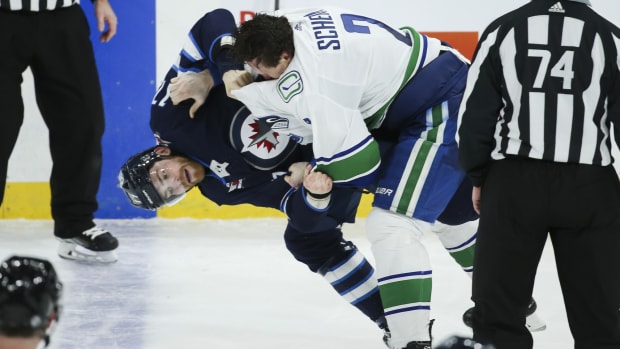
When Paul Maurice resigned as head coach of the Winnipeg Jets on Dec. 17, some hockey observers wondered just what he was thinking. Granted, the Jets were in the midst of a 5-8-2 skid, but many, if not most people saw them as a talented group – and believed they could be a playoff spot if they quickly turned things around.
Unfortunately for the Jets, that’s not what happened. Since Maurice departed (and was replaced by interim head coach Dave Lowry), Winnipeg has gone 5-5-2, and they currently have a 1-4-2 mark in their past seven games, including a six-game losing streak that ended with one measly victory (over St. Louis on Jan. 29).
It looks as if Maurice knew exactly how problematic this edition of the Jets really are before he bailed out. And when you look at the bigger picture for Winnipeg, you start to see the fraying of GM Kevin Cheveldayoff’s blueprint for success.
The Jets began this season looking decent enough – their 9-3-3 record out of the gate kept them competitive in the Central Division, but things began to go sideways after that: a five-game losing streak in late November was sobering enough for Winnipeg fans, and a three-game skid just before the NHL paused the season in late December showed Maurice wasn’t the problem.
What is the problem? Well, offense, for one thing. The Jets currently sit tied for 17th in goals-for average per game (2.98), and during their five-game losing streak in December, they generated only five goals. Yes, you have to note they’ve been gnawed on by the injury bug and the COVID-19 virus: Captain Blake Wheeler has been limited to only 23 games, and forwards Paul Stastny, Mark Schiefele, Nik Ehlers have missed at least six games, and at the high end, 11 games. They don’t get a free pass for that, but it does make a difference in what they can do at both ends of the ice.
And their defense doesn’t make up for the offense drying up, with their penalty kill a dismal 30th-overall at jusr 73.1 percent. Goalie Connor Hellebuyck his been phenomenal in recent years, but he hasn’t been his usual dominant self this season, posting a pedestrian .909 save percentage and 2.93 goals-against.
But sometimes, we forget just how much the Jets have lost of late. It wasn’t that long ago their defense corps was led by Dustin Byfuglien, Jacob Trouba, Tyler Myers and Tobias Enstrom. None of them were perfect players, but together, they gave Winnipeg its backbone and took enormous pressure off younger D-men and Hellebuyck. Now, that pressure is back on the back end, and they have buckled on more than a few occasions.
The Jets are 14 standings points out of a playoff berth in the Central. The seventh-place Chicago Blackhawks are only four points behind Winnipeg, though the Jets have four games in hand. We’re at the midway point in the season, and the writing is on the wall for Winnipeg. Cheveldayoff has important decisions to make on soon-to-be-unrestricted free agents Stastny and forward Andrew Copp, and he has a slew of restricted free agents this summer, including forwards Pierre-Luc Dubois, and Kristian Vesalainen. The Jets already have (per CapFriendly.com) more than $71.5 million committed to only 12 players next year. Something has got to give.
Things are bleak for the Jets for the moment, but they do have some talented players worth holding onto. The questions are, firstly, is Cheveldayoff still the right person to chart this team’s future; and secondly, which parts of the core do you look at offering up on the trade market and seeing what the results could be.
The main issue here is the particular mix of players, certainly short-term, but more importantly, for the long haul. It’s not working on a level to truly compete with the Colorados and Vegases of the Western Conference. The status quo is not the answer. You have to go in a different direction.
Maurice knew it. Surely by now, Cheveldayoff must know it. And most importantly, the paying customers know it. Change is on the horizon in Winnipeg, and deservedly so.
